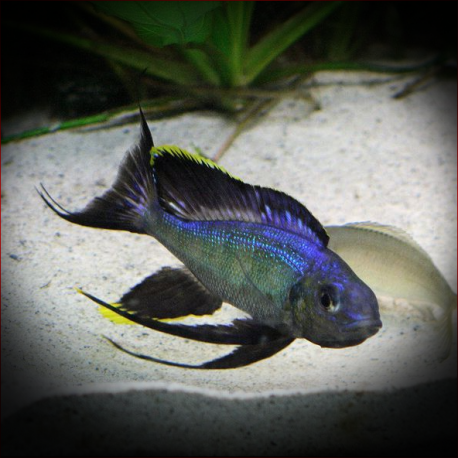More info
Datasheet
| Minimum Tank Size | 365 litres / 96.42 US gallons |
| Maximum Size | 20.0cm / 7.87inches |
| Temperature | 24°C / 75.20°F - 27°C / 80.60°F |
| Hardness | 8-25ºdH |
| pH | 8.0-9.0 |
General Description
The Featherfin Cichlid, specifically the Cyathopharynx Furcifer species, is characterized by its stunning beauty, with males showcasing vibrant colors once they reach around 4 inches in length. With only two described species, each having several color forms, these fish are highly coveted in the hobbyist world. They require pristine water conditions to fully develop their adult coloration, which can take months, especially for younger specimens.
Aquarium Setup
Setting up an aquarium for the Featherfin Cichlid involves creating an environment with scattered rocks for cave formations, spacious open water areas, and a sandy substrate. It is crucial to provide good biological filtration and hard water-tolerant plant species like Anubias or Vallisneria. Maintaining water parameters between 24-27°C temperature, pH of 8.0-9.0, and water hardness of 8-25°dH is essential for their well-being.
Behaviour
Known to be relatively boisterous, the Featherfin Cichlid needs ample space and should be the dominant species in the tank to avoid becoming withdrawn. Male fish can lose coloration if not in a dominant position. It is advised to house them with peaceful species that can hold their own and avoid aggressive tankmates like Mbuna. Compatible tankmates include larger Cyprichromis sp. and Altolamprologus sp.
Feeding and Diet
Featherfin Cichlids will accept a variety of foods but should primarily be fed a diet rich in vegetable matter. Offer a mix of blanched spinach, natural nori, and high-quality spirulina flakes or pellets. It is recommended to avoid high-protein, meaty foods for their diet to ensure their nutritional needs are met.
Reproduction & Dimorphism
These fish are maternal mouthbrooders, requiring a large tank with sandy substrate for breeding. Males create spawning sites in the substrate to attract females. Females will carry the brood of 10-40 eggs in their mouths for up to 3 weeks before releasing the fry. Males are larger and more colorful than females, displaying longer fins, especially in the ventral region.
Habitat and Distribution
Endemic to Lake Tanganyika, the Featherfin Cichlid, Cyathopharynx Furcifer, inhabits intermediate zones in the lake with scattered rocks and sandy bottoms. This species is widespread throughout Lake Tanganyika, favoring areas with suitable rocky and sandy substrates for their natural habitat.

